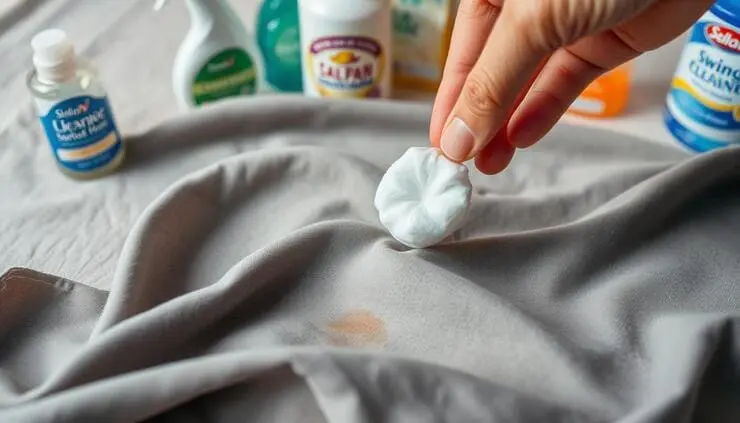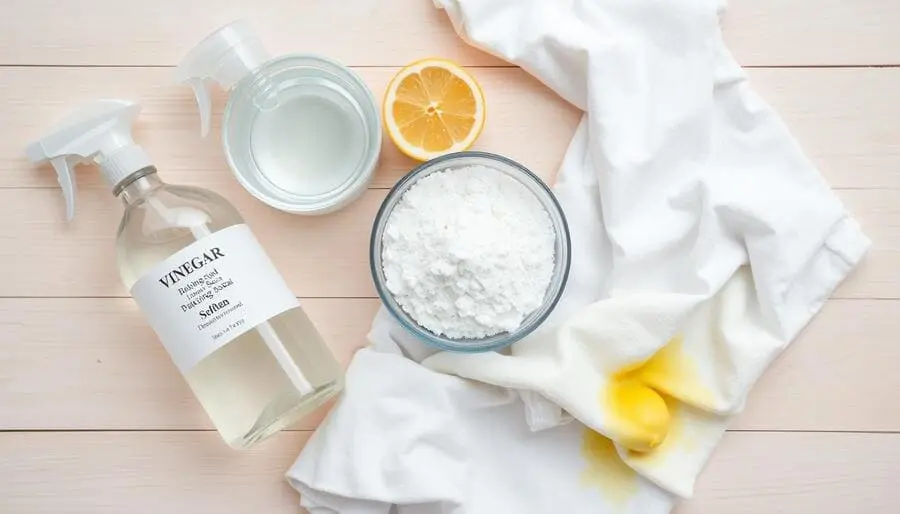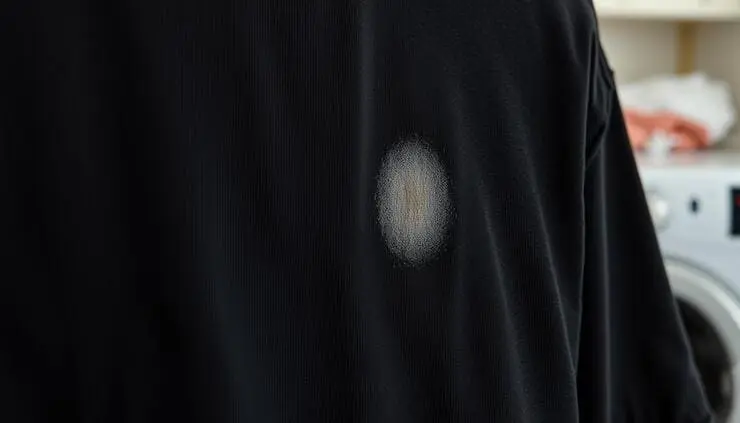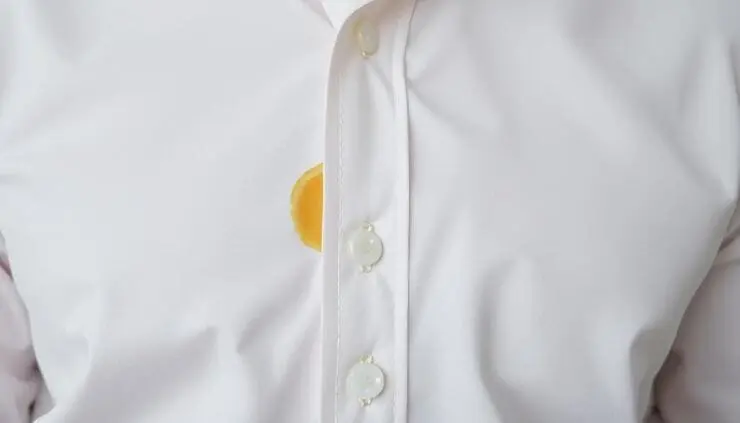Deodorant stains are a common problem for many. They can ruin the look of your clothes and even damage the fabric. But don’t worry, removing deodorant stains is possible. This guide will show you how to remove deodorant stains from different fabrics. You’ll learn how to tackle fresh stains and set-in marks using household items and deodorant stain removal products.
Discover how to prevent stains to keep your clothes looking great. This way, you can keep your clothing care routine going strong.
By the end of this article, you’ll know how to handle deodorant stains on any fabric. Say goodbye to white marks and yellow spots.
Deodorant stains happen when your personal care products mix with your clothes’ fibers. This can lead to discoloration, white marks, and fabric damage. The type of fabric, how often you wear it, and the deodorant you use all play a role in how bad the stain is.
There are two main types of deodorant stains: white marks and yellowing. White marks come from aluminum in deodorants, leaving a residue. Yellowing is caused by oils and fragrances, making your clothes look discolored. Knowing the difference helps you choose the right way to clean them.
Table of Contents
Pre-Treatment: Preparing Clothes for Stain Removal

Before tackling deodorant stains, it’s key to get your clothes ready. The right pre-treatment can greatly improve stain removal success. Here, we’ll cover the must-do’s and don’ts, and why spot testing is vital. Your clothes will remain clean and fresh as a result.
Here are some important tips for pre-treatment:
- Do check the care label to avoid damage.
- Don’t rub the stain hard, as it can embed deeper.
- Do blot the stain gently with a damp cloth.
- Do apply a pre-treatment product for pre-treatment, stain removal preparation, or spot testing.
Always do a spot test on a hidden area before removing stains. This ensures the cleaning method or product won’t harm the fabric. It prevents damage or color loss. Spot testing is a small step that can save your favorite clothes.
| Dos | Don’ts |
|---|---|
| Check the care label | Rub or scrub the stain vigorously |
| Gently blot the stain | Use hot water |
| Use a pre-treatment product | Skip the spot test |
DIY Solutions for Removing Fresh Deodorant Stains

Dealing with fresh deodorant stains on your clothes can be frustrating. With a few simple items, you can remove those pesky stains quickly. Let’s look at some DIY stain removal remedies to make your clothes look fresh and clean.
Baking soda, white vinegar, and lemon juice are great for DIY stain removal. They can work wonders on fresh deodorant stains. Here’s how to use them:
- Baking Soda: Make a paste with baking soda and water, then gently rub it into the stain. Leave it and then wash as usual.
- White Vinegar: Dilute some vinegar with water and sponge it onto the stain.
- Lemon Juice: Squeeze some lemon juice directly onto the stain and let it sit for a bit before washing. The citric acid in lemon works as a natural bleaching agent.
Step-by-Step Guide to Treating Fresh Stains
Tackling fresh deodorant stains quickly is key to successful removal. For optimal outcomes, adhere to following steps:
- Blot the stain with a clean, absorbent cloth or paper towel to soak up as much of the deodorant as possible.
- Apply your chosen household stain remedy, such as baking soda, vinegar, or lemon juice, directly to the stain.
- Let the treatment sit for 5-10 minutes to allow it to work its magic.
- Gently rub the stain with soft-bristled brush.
- Rinse the area with cold water.
With these simple DIY stain removal techniques, you can say goodbye to those pesky deodorant stains. Keep your clothes looking their best.
RELATED : Dry Clean Clothes at Home : Freshen Your Wardrobe Save Time and Money
Removing Deodorant Stains From Black Clothes

Removing deodorant stains from black clothes is tough. The dark fabric hides the white marks or yellow spots. But, with the right methods, you can get rid of these stains and keep your black clothes looking great.
First, tackle the white marks on black clothes. These come from aluminum in deodorants. Rub the area with a damp cloth and a bit of baking soda. The baking soda gently removes the stain without harming the fabric.
For yellow stains, mix equal parts white vinegar and water. Use this solution to dab the stain, then leave it for a few minutes. Then, rinse well. The vinegar’s acidity breaks down the stain-causing compounds.
- Use baking soda to remove white deodorant marks on black clothes
- Mix white vinegar and water to tackle yellow underarm stains
- Hot water might fix the stain and make it more difficult to remove, so avoid using it.
When removing stains from dark fabrics, be patient and gentle. Don’t scrub hard, as it can damage the fabric. Rather, use a fresh cloth or paper towel to dab at the stain. With some effort and the right techniques, your black clothes will stay stain-free.
Removing Deodorant Stains From White Clothes

Dealing with deodorant stains on white clothes can be frustrating. Yellowing stains from deodorant can be hard to remove. But, we have some brightening techniques to help your whites shine.
To remove deodorant stains, try baking soda and hydrogen peroxide. Mix these to make a paste. Apply it and let it sit for 20 minutes. Baking soda lifts the stain, and hydrogen peroxide brightens the fabric.
Soaking your clothes in warm water, white vinegar, and dish soap is also effective. Before washing, soak for at least an hour.
- Use a dedicated stain remover for white fabrics to target deodorant stains.
- Use cold or lukewarm water instead.
- Future yellowing can be avoided by using whitening laundry detergent when washing white clothing.
By using these techniques, you can remove deodorant stains and keep your white clothes fresh. Remember, preventing stains is key. Be careful with your deodorant and choose products that don’t stain.
Tackling Set-In Deodorant Stains
Don’t let stubborn, set-in deodorant stains ruin your favorite clothes. With the right techniques and products, you can effectively remove even the most persistent stains. From specialized soaking methods to targeted cleaning solutions, we’ve got you covered.
Effective Methods for Dealing with Older Stains
When dealing with old deodorant stains, a more robust approach is needed. Start by pre-treating the stain with a stain remover or laundry detergent made for tough stains. Let it sit for a few minutes before gently agitating the fabric to break down the stain.
Soaking Techniques That Actually Work
For deeply embedded deodorant stains, soaking the garment in warm water and oxygen-based bleach works well. Let it soak for 30 minutes, this soaking process helps lift and dissolve the stain, making it easier to remove during washing.
| Stain Removal Technique | Effectiveness | Fabric Suitability |
|---|---|---|
| Pre-treatment with stain remover | High | Most fabrics |
| Soaking in warm water and oxygen-based bleach | Very High | White and colorfast fabrics |
Before using any cleaning solution or technique, always test it on a little, discrete area. This ensures it won’t cause discoloration or damage to the fabric. With patience and the right approach, you can conquer even the most stubborn set-in deodorant stains.
Preventing Deodorant Stains in the First Place
The ingredients in your deodorant are crucial for stain prevention. Aluminum-based compounds can cause discoloration. Choose aluminum-free deodorants instead.
- Apply deodorant before getting dressed. This gives the product time to fully dry and set, reducing the chance of transfer to your clothes.
- Use a light touch when applying. Excessive amounts of deodorant are more likely to rub off onto your garments.
- Focus on applying deodorant to the underarm area, rather than sweeping it across your entire torso.
- Allow ample drying time before putting on your shirt or blouse. Waiting a few extra minutes can make a big difference.
By making a few simple adjustments to your deodorant routine, you can prevent those pesky stains and keep your clothes looking their best for longer.
Conclusion: Keeping Clothes Fresh and Stain-Free
Removing deodorant stains from clothes can be a challenge. By using the tips from this article, you’ll learn how to remove and prevent deodorant stains effectively.
Regular laundry routines and careful deodorant use are crucial. Use DIY solutions like baking soda, vinegar, and lemon for fresh stains. For set-in stains, try more robust methods. Choose the right deodorant and apply it carefully to avoid stains.
With a bit of effort and the right knowledge, your clothes will stay in top condition. Use these stain-busting techniques in your laundry routine. This way, you’ll always have confidence in the freshness and cleanliness of your clothes.
